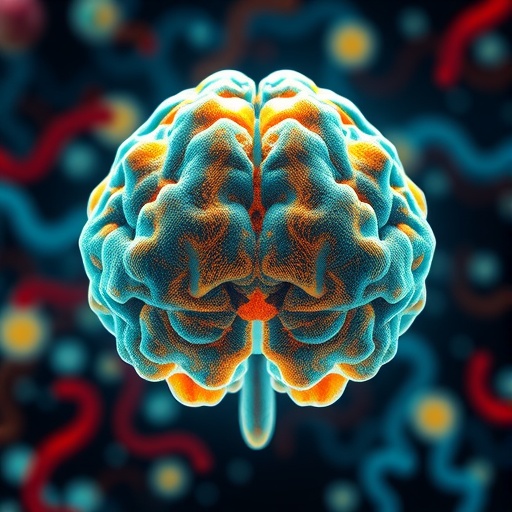
In a groundbreaking study published in Biology of Sex Differences, researchers have embarked on a pioneering journey to unveil the intricate proteomic landscape of the hippocampus in both male and female mice subjected to an early model of Alzheimerâs disease. This research not only sheds light on the biological underpinnings that differentiate the sexes in the context of neurodegeneration but also opens up new avenues for tailored therapeutic strategies. The hippocampus, a crucial region of the brain associated with memory and spatial navigation, exhibits significant vulnerability to Alzheimer’s disease, prompting investigators to explore its spatial proteomic signature.
The study, led by Contreras, Jiménez-Herrera, and Djebari, employed state-of-the-art techniques in spatial proteomics to map out proteins with varying expressions between male and female mice. The researchers utilized advanced mass spectrometry and imaging techniques to capture a comprehensive view of protein distribution within the hippocampal region. This meticulous approach allowed them to identify and quantify numerous proteins, making it possible to discern differences that may be linked to the observed variations in behavioral responses to Alzheimerâs pathology across sexes.
By focusing on the hippocampus, the research team aimed to pinpoint distinct protein signatures that may play vital roles in the progression of Alzheimerâs disease. Their findings suggest that males and females not only show differences in the incidence of this neurodegenerative condition but also exhibit diverse biological responses to its initiation. For instance, previous studies have shown that females tend to manifest Alzheimer’s symptoms at earlier ages compared to males, and this sex-based divergence in pathology indicates that biological sex may be a significant factor in understanding the diseaseâs trajectory.
One of the children insights from this comprehensive mapping was the identification of a set of proteins, particularly those involved in synaptic function and neuroinflammation, that exhibited notable variance in their expression levels between sexes. These proteins are imperative for synaptic plasticity, a phenomenon that is crucial for learning and memory processes. The disruption of such proteins could signify an early marker for Alzheimerâs progression, allowing for earlier intervention strategies tailored to individual needs based on sex.
The potential implications of these findings are profound. With the current lack of effective disease-modifying treatments for Alzheimerâs, understanding proteomic changes on a spatial scale could play a pivotal role in the early detection and monitoring of the disease. Furthermore, it could inform the development of sex-specific therapeutic interventions that address the unique biological pathways at play in males and females, leading to more personalized and effective treatment regimens.
Interestingly, the study also highlights the necessity for more gender-balanced research in neurodegenerative diseases. Historically, a bias towards male subjects in clinical and preclinical studies has skewed our understanding of conditions like Alzheimer’s, which disproportionately affects women. This research exemplifies the importance of including both sexes in scientific investigations to create a comprehensive understanding of disease mechanisms and potential therapeutic targets.
Additionally, the implications of social factors and environmental influences on the hippocampal proteomic signature cannot be overlooked. The complex interplay between genetics, lifestyle, and environmental stressors may exacerbate or alleviate the onset of Alzheimer’s disease symptoms, further emphasizing the need for multifaceted research approaches. Future studies could build upon these findings by incorporating various environmental factors to evaluate their impact on the hippocampal proteome in both males and females.
Importantly, the study sets a precedent for subsequent investigations aiming to unravel the molecular mechanisms that underlie the sex differences observed in Alzheimerâs disease. The establishment of a detailed proteomic map opens doors to further exploration of the pathways involved in neurodegeneration. Research endeavors following this trajectory could elucidate how variations in protein expression contribute to the disparate clinical manifestations of Alzheimerâs in affected individuals.
Moreover, the use of animal models offers a unique perspective, enabling researchers to explore disease mechanisms in a controlled setting. The insights gained from these studies are not only relevant to understanding Alzheimer’s disease but also extend to a broader context of neurobiology. By establishing how sex influences proteomic expression, scientists can gain a deeper appreciation of the biological factors that shape individual responses to neurological diseases.
As the field of neurodegenerative research continues to evolve, the findings from this study will likely serve as a catalyst for future investigations. Gaining a granular understanding of the proteomic differences between sexes can instigate more effective strategies to combat Alzheimer’s disease and, potentially, other neurodegenerative conditions. Ensuring that future studies are balanced in terms of sex representation will be critical to accelerating the development of targeted therapies that cater to the unique needs of all patients.
Through pioneering efforts such as these, the scientific community is one step closer to unraveling the complexities of Alzheimerâs disease and, ultimately, improving outcomes for millions of individuals grappling with the consequences of neurodegeneration. This work underscores the importance of interdisciplinary approaches and highlights how integrating various fields of study can lead to transformative insights and approaches in health and medicine.
In conclusion, the exploration of the hippocampal spatial proteomic signature in male and female mice represents a significant advancement in our understanding of Alzheimer’s disease. By highlighting the differences in protein expression between sexes, this research not only augments our knowledge of the disease’s biological basis but also lays the groundwork for innovative therapeutic strategies that may lead to improved interventions. As we move forward, embracing a holistic view of disease research will be critical in addressing the complex challenges posed by Alzheimer’s and similar neurodegenerative diseases.
Subject of Research: Mapping the hippocampal spatial proteomic signature in a model of early Alzheimerâs disease
Article Title: Mapping the hippocampal spatial proteomic signature in male and female mice of an early Alzheimerâs disease model.
Article References: Contreras, A., Jiménez-Herrera, R., Djebari, S. et al. Mapping the hippocampal spatial proteomic signature in male and female mice of an early Alzheimerâs disease model. Biol Sex Differ 16, 36 (2025). https://doi.org/10.1186/s13293-025-00697-5
Image Credits: AI Generated
DOI:
Keywords: Alzheimer’s disease, hippocampus, sex differences, spatial proteomics, neurodegeneration, personalized therapy
Tags: Alzheimer’s disease progression factorsAlzheimer’s disease sex differencesAlzheimerâs research innovations.behavioral responses to Alzheimer’s pathologygender-specific brain proteinshippocampal proteomics in micehippocampus and memorymass spectrometry in neuroscienceneurodegeneration research studyprotein distribution in the brainspatial proteomic analysistailored therapeutic strategies for Alzheimer’s




